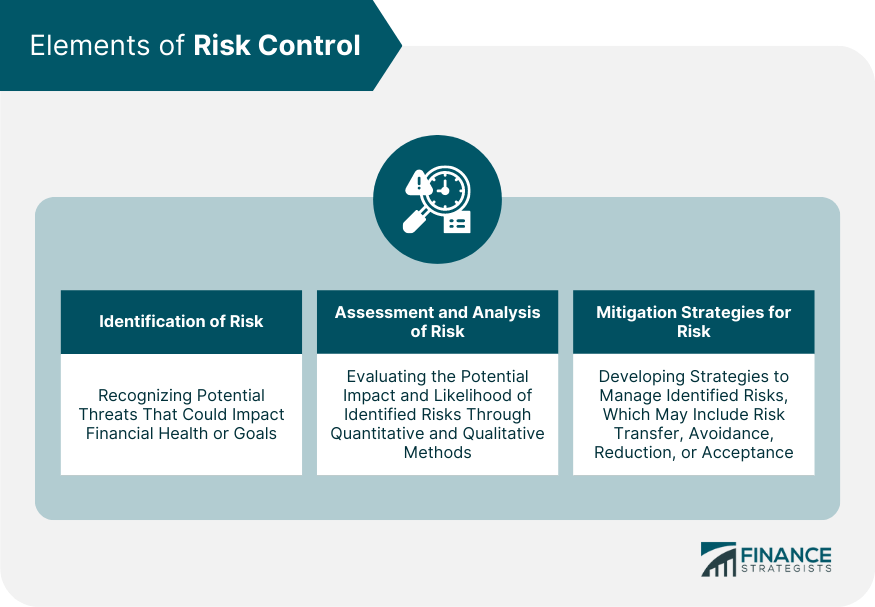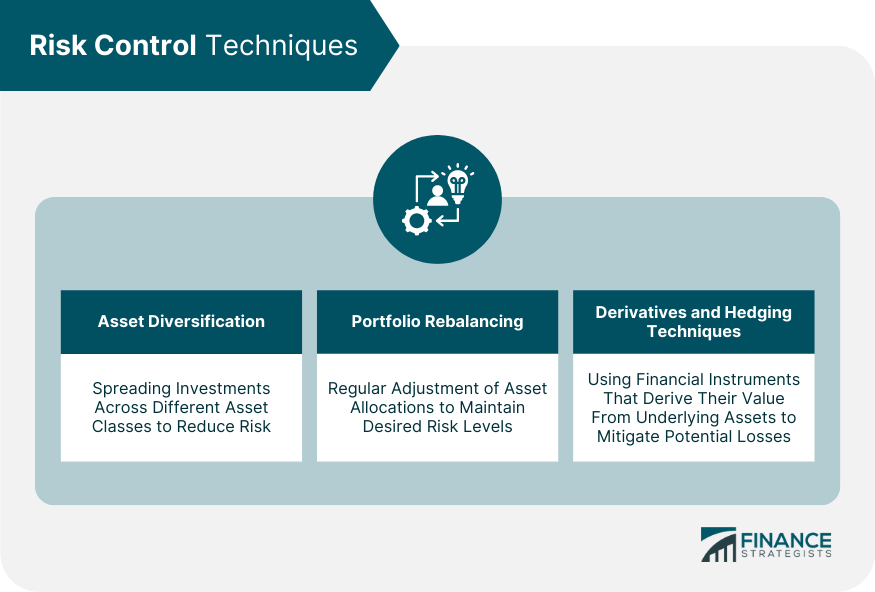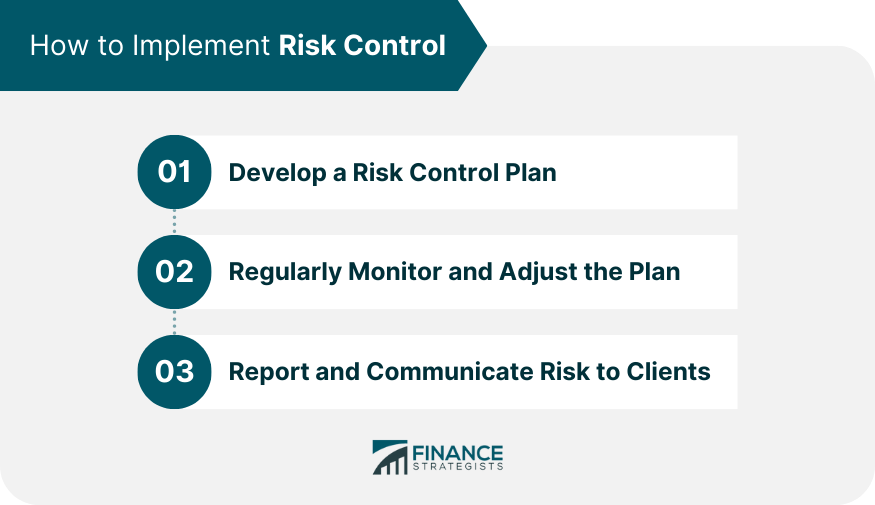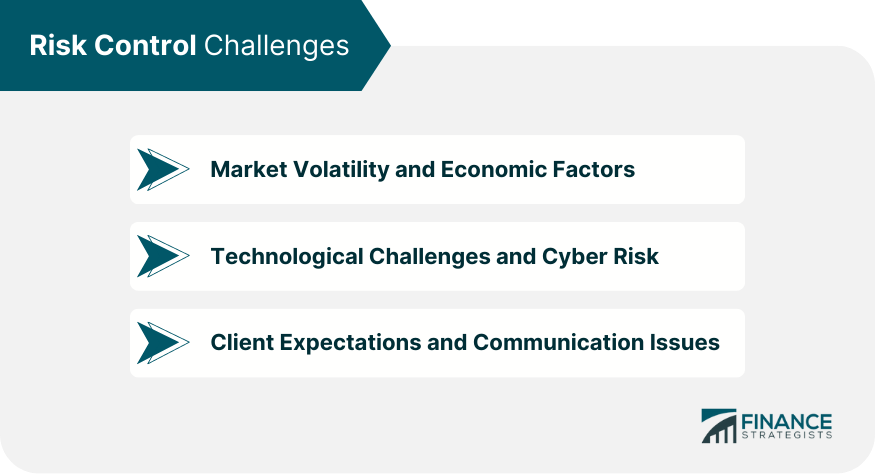Risk control is a systematic approach to identifying, assessing, and mitigating potential threats that can impact an organization or investment. These threats, or 'risks,' may originate from a range of sources, such as financial uncertainty, legal liabilities, strategic management mistakes, accidents, or natural disasters. This process plays a crucial role in financial strategies, particularly in wealth management, as it aids in protecting clients' assets, maintaining their financial well-being, and facilitating the achievement of their financial objectives. Besides, risk control contributes to the overall stability of the financial system. The procedure entails a combination of risk assessment, implementation of risk mitigation strategies, and continuous monitoring to detect alterations in the risk environment. Together, these steps create a comprehensive risk management plan that addresses and mitigates both immediate and long-term threats. Risk control involves three primary steps: risk identification, risk assessment, and risk mitigation. This first step involves recognizing the potential threats or risks that could negatively impact a client's financial health or ability to achieve their financial goals. These risks can range from market volatility, economic downturns, or even changes in the client's personal circumstances. Once potential risks have been identified, the next step is to evaluate their potential impact and the likelihood of their occurrence. This process often involves a mixture of quantitative analysis (such as statistical models) and qualitative assessment (such as expert judgment). After assessing the risks, wealth managers then develop strategies to manage them effectively. These strategies can range from transferring the risk to another party, avoiding the risk, reducing the negative effect or probability of the risk, or even accepting some or all of the potential or actual consequences of a particular risk. A risk profile is a snapshot of an individual's willingness and ability to take financial risks. It considers various factors, such as the individual's financial goals, investment horizon, financial knowledge, and personal comfort with taking risks. Understanding a client's risk profile is crucial for effective risk control. It helps wealth managers tailor their risk control strategies to the individual client's needs and preferences. For example, a client with a high-risk tolerance may be more comfortable with riskier investments that offer higher potential returns, while a client with a low-risk tolerance may prefer safer investments. A client's risk profile is typically determined through a risk assessment questionnaire. This questionnaire will ask about the client's financial goals, investment horizon, knowledge about investing, and feelings about risk and potential losses. The responses are then used to classify the client into a risk category, such as conservative, moderate, or aggressive. There are several techniques that wealth managers can use to control risk. Asset diversification involves spreading investments across various asset classes to reduce risk. This strategy is based on the principle that different asset classes will perform differently at different times, so by diversifying, you can reduce the impact of poor performance in any one asset class. Rebalancing is the process of realigning the weightings of a portfolio of assets. Rebalancing involves periodically buying or selling assets in a portfolio to maintain an original or desired level of asset allocation or risk. Derivatives are financial instruments that derive their value from an underlying asset. They can be used to hedge against potential losses in an investment portfolio. Hedging involves making an investment to reduce the risk of adverse price movements in an asset. Effective risk control requires a systematic approach that includes developing a risk control plan, monitoring the plan, and communicating the risk to clients. A risk control plan outlines the strategies and actions to manage and mitigate risk. It should be tailored to the client's risk profile and financial goals. Risk control is not a one-time task but requires regular monitoring and adjustment. This is because the financial markets, the economy, and the client's personal circumstances can change over time, which can affect the level and types of risk. Wealth managers need to communicate the risk and the risk control strategies clearly to their clients. This is not only essential for maintaining trust with the client but also for ensuring that the client is comfortable with the risk level in their portfolio. Regulatory compliance refers to the adherence to laws, regulations, guidelines, and specifications relevant to the business or investment. In wealth management, these regulations can come from various sources, such as governments, regulatory bodies, and internal policies. Regulatory compliance plays a crucial role in risk control. By adhering to the relevant regulations, wealth managers can avoid legal and financial penalties, which can be a significant risk. Moreover, many regulations in the financial industry are designed to manage and control risk. Compliance strategies for risk control can include regular compliance training for employees, the establishment of a compliance department, regular audits, and the use of compliance software. The financial markets can be unpredictable, and economic conditions can change rapidly. These factors can introduce significant risk and make risk control challenging. With the increasing use of technology in wealth management, cyber risk has become a significant concern. Protecting against cyber threats and ensuring data security are crucial aspects of risk control. Clients can have varying expectations about risk and returns, which can make risk control challenging. Moreover, effectively communicating about risk and risk control strategies can also be challenging. Risk control involves identifying, assessing, and mitigating risks to safeguard the clients' assets and help them meet their financial goals. The essence of risk control lies in the thorough assessment of potential threats, followed by the implementation of effective mitigation strategies. Techniques utilized in risk control extend to asset diversification, portfolio rebalancing, and strategic use of derivatives for hedging. Understanding these elements allows for a more nuanced approach to risk management, ensuring the protection of wealth amidst the dynamics of financial markets. Thus, a solid grasp of risk control, its core elements, and practical techniques become vital tools for financial advisors seeking to maximize client wealth and minimize exposure to potential threats.What Is Risk Control?
Elements of Risk Control
Identification of Risk
Assessment and Analysis of Risk
Mitigation Strategies for Risk

Risk Profile and Its Role in Risk Control
Understanding Risk Profile
Importance of Risk Profile in Risk Control
How to Determine a Client's Risk Profile
Risk Control Techniques
Asset Diversification
Rebalancing Portfolio
Derivatives and Hedging Techniques

Implementing Risk Control
Development of a Risk Control Plan
Regular Monitoring and Adjustment of the Plan
Reporting and Communication of Risk to Clients

Risk Control and Regulatory Compliance
Overview of Regulatory Compliance
Role of Regulatory Compliance in Risk Control
Compliance Strategies for Effective Risk Control
Risk Control Challenges
Market Volatility and Economic Factors
Technological Challenges and Cyber Risk
Client Expectations and Communication Issues

Bottom Line
Risk Control FAQs
Risk control in wealth management refers to the process of identifying, assessing, and managing risks to protect a client's wealth and help them achieve their financial goals.
A client's risk profile is typically determined through a risk assessment questionnaire. The responses to the questionnaire are used to classify the client into a risk category, such as conservative, moderate, or aggressive.
Some risk control techniques in wealth management include asset diversification, portfolio rebalancing, and the use of derivatives and hedging techniques.
Some challenges to risk control include market volatility, technological challenges and cyber risk, and varying client expectations and communication issues.
Technology, such as artificial intelligence and machine learning, can help in more accurate risk identification and assessment. Moreover, technology can also help in implementing more effective risk control strategies.
True Tamplin is a published author, public speaker, CEO of UpDigital, and founder of Finance Strategists.
True is a Certified Educator in Personal Finance (CEPF®), author of The Handy Financial Ratios Guide, a member of the Society for Advancing Business Editing and Writing, contributes to his financial education site, Finance Strategists, and has spoken to various financial communities such as the CFA Institute, as well as university students like his Alma mater, Biola University, where he received a bachelor of science in business and data analytics.
To learn more about True, visit his personal website or view his author profiles on Amazon, Nasdaq and Forbes.















